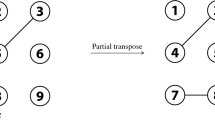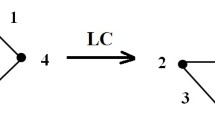Abstract
In this article, we study the entanglement properties of multi-qubit quantum states using a graph-theoretic approach. For this, we define entanglement and separability for m-qubit quantum states associated with a weighted graph on \(2^m\) vertices. We further explore the properties of a block graph and a star graph to demonstrate criteria for entanglement and separability of these graphs.
Similar content being viewed by others
Data Availability statement
All data generated or analyzed during this study are included in this published article.
Abbreviations
- 1. \(||x ||\) :
-
Absolute value of x= (\(\sqrt{x {\bar{x}}}\)).
- 2. \({\mathrm{Tr}}(A)\) :
-
Trace of a matrix A.
- 2. \({\mathrm{det}}(A)\) :
-
Determinant of a matrix A.
- 4. D(G):
-
The degree matrix of (G, a).
- 5. \({\rho _G}^{PT}\) :
-
Partial transpose of the density operator of a graph G.
- 6. \({\bar{\rho _G}}^{PT}\) :
-
Conjugate partial transpose of the density operator of a graph G.
- 7. \(A^*\) :
-
Conjugate transpose of A.
- 8. \(|{E(G)}|\) :
-
Number of edges in G.
References
Adhikari, B., Banerjee, S., Adhikari, S., Kumar, A.: Laplacian matrices of weighted digraphs represented as quantum states. Quantum Inf. Process. 16(3), 79 (2017)
Bennett, C.H., DiVincenzo, D.P., Smolin, J.A., Wootters, W.K.: Mixed-state entanglement and quantum error correction. Phys. Rev. A 54(5), 3824 (1996)
Berkolaiko, G., Kuchment, P.: Introduction to Quantum Graphs. Number 186. American Mathematical Society (2013)
Braunstein, S.L., Ghosh, S., Mansour, T., Severini, S., Wilson, R.C.: Some families of density matrices for which separability is easily tested. Phys. Rev. A 73(1), 012320 (2006)
Braunstein, S.L., Ghosh, S., Severini, S.: The Laplacian of a graph as a density matrix: a basic combinatorial approach to separability of mixed states. Ann. Comb. 10(3), 291–317 (2006)
Bruss, D., Leuchs, G.: Quantum Information: From Foundations to Quantum Technology Applications. Wiley, New York (2019)
Coffman, V., Kundu, J., Wootters, W.K.: Distributed entanglement. Phys. Rev. A 61(5), 052306 (2000)
Dür, W., Aschauer, H., Briegel, H.-J.: Multiparticle entanglement purification for graph states. Phys. Rev. Lett. 91(10), 107903 (2003)
Dür, W., Vidal, G., Cirac, J.I.: Three qubits can be entangled in two inequivalent ways. Phys. Rev. A 62(6), 062314 (2000)
Dutta, S., Adhikari, B., Banerjee, S.: A graph theoretical approach to states and unitary operations. Quantum Inf. Process. 15(5), 2193–2212 (2016)
Dutta, S.: Bipartite separability and nonlocal quantum operations on graphs. Phys. Rev. A 94(1), 012306 (2016)
Eisert, J., Plenio, M.B.: Introduction to the basics of entanglement theory in continuous-variable systems. Int. J. Quantum Inf. 1(04), 479–506 (2003)
Hall, B.C.: Quantum Theory for Mathematicians, vol. 267. Springer, Berlin (2013)
Hall, M.J.W.: Random quantum correlations and density operator distributions. Phys. Lett. A 242(3), 123–129 (1998)
Hassan, A.S.M., Joag, P.S.: A combinatorial approach to multipartite quantum systems: basic formulation. J. Phys. A Math. Theor. 40(33), 10251 (2007)
Hildebrand, R., Mancini, S., Severini, S.: Combinatorial Laplacians and positivity under partial transpose. Math. Struct. Comput. Sci. 18(1), 205–219 (2008)
Horodecki, M., Horodecki, P., Horodecki, R.: Separability of n-particle mixed states: necessary and sufficient conditions in terms of linear maps. Phys. Lett. A 283(1–2), 1–7 (2001)
Horodecki, R., Horodecki, P., Horodecki, M., Horodecki, K.: Reviews of modern physics. Quantum Entangl 81(2), 865 (2009)
Hou, Q.-H., Mansour, T., Severini, S.: Partial transposes of permutation matrices. Integers Electron J Combin Number Theory 8(A49), A49 (2008)
Joshi, A., Singh, R., Kumar, A.: Concurrence and three-tangle of the graph. Quantum Inf. Process. 17(12), 327 (2018)
Lohmayer, R., Osterloh, A., Siewert, J., Uhlmann, A.: Entangled three-qubit states without concurrence and three-tangle. Phys. Rev. Lett. 97(26), 260502 (2006)
Meenakshi, A.R., Rajian, C.: On a product of positive semidefinite matrices. Linear Algebra Appl. 295(1–3), 3–6 (1999)
Milivojević, M.: Maximal thermal entanglement using three-spin interactions. Quantum Inf. Process. 18(2), 1–14 (2019)
Newman, M.W.: The Laplacian spectrum of graphs (2001)
Nielsen, M.A., Chuang, I.: Quantum computation and quantum information (2002)
Nielsen, M.A., Chuang, I.L.: Quantum computation and quantum information (2000)
Rigolin, G.: Superdense coding using multipartite states. arXiv:hep/0407193 (2004)
Rigolin, G.: Quantum teleportation of an arbitrary two-qubit state and its relation to multipartite entanglement. Phys. Rev. A 71(3), 032303 (2005)
Wang, B.-Y., Gong, M.-P.: Some eigenvalue inequalities for positive semidefinite matrix power products. Linear Algebra Appl. 184, 249–260 (1993)
Wang, X., Wilde, M.M.: Cost of quantum entanglement simplified. Phys. Rev. Lett. 125(4), 040502 (2020)
Werner, R.F.: Quantum states with Einstein–Podolsky–Rosen correlations admitting a hidden-variable model. Phys. Rev. A 40(8), 4277 (1989)
West, D.B., et al.: Introduction to Graph Theory, vol. 2. Prentice Hall, Upper Saddle River (2001)
Wilson, R.J.: Introduction to Graph Theory. Pearson Education, New York (1979)
Wootters, W.K.: Entanglement of formation of an arbitrary state of two qubits. Phys. Rev. Lett. 80(10), 2245 (1998)
Wootters, W.K.: Entanglement of formation and concurrence. Quantum Inf. Comput. 1(1), 27–44 (2001)
Wu, P.Y.: Products of positive semidefinite matrices. Linear Algebra Appl. 111, 53–61 (1988)
Zhang, F., Zhang, Q.: Eigenvalue inequalities for matrix product. IEEE Trans. Autom. Control 51(9), 1506–1509 (2006)
Zhang, G.-F.: Thermal entanglement and teleportation in a two-qubit Heisenberg chain with Dzyaloshinski–Moriya anisotropic antisymmetric interaction. Phys. Rev. A 75(3), 034304 (2007)
Acknowledgements
The authors are grateful to Ranveer Singh and Satish Sangwan for their valuable comments and suggestions. The authors are also grateful to IIT Jodhpur for providing the research infrastructure. On behalf of all authors, the corresponding author states that there is no conflict of interest.
Author information
Authors and Affiliations
Corresponding author
Additional information
Publisher's Note
Springer Nature remains neutral with regard to jurisdictional claims in published maps and institutional affiliations.
Appendix
Appendix
1.1 A brief explanation of Examples (6) and (7)
-
1.
Explanation of the example (6)

The density operator for the graph \(G_2\) can be represented as
Using \(\rho _{G_2}\) , one can verify that \(\rho _{G_2} \ne {{\rho _{G_2}}}^{PT}\). Therefore, interchanging columns \(C_9\) with \(C_{11}\), and \(C_{14}\) with \(C_{16}\) and corresponding rows \(R_9\) with \(R_{11}\) and \(R_{14}\) with \(R_{16}\), we have
Here, we can see that blocks are symmetric, satisfying the Theorem 4.4. Hence, the state associated with the graph \(G_2\) is separable.
-
2.
Explanation of the example (7)

Similar to the previous case, the density operator for the graph \(G_3\) is expressed as
In this case, we can see that we cannot get the symmetric blocks by interchanging the columns and corresponding rows. Therefore, the state associated with the graph \(G_3\) is entangled.
1.2 Decomposition of the Laplacian matrix of a simple graph G
Every Laplacian matrix can be decomposed as a sum of Laplacian matrices of subgraphs (\(G_1\), \(G_2\), and \(G_3\)) of a graph G [24].
We have
It is easy to see that L(G) can be rewritten as
To summarize, \(L(G)=\begin{bmatrix} L_1&{}0\\ 0&{}0 \end{bmatrix}+ \begin{bmatrix} 0&{}0\\ 0&{}L_2 \end{bmatrix} + \begin{bmatrix} D_1&{}B_1\\ {B_2} &{}D_2 \end{bmatrix}\),
where \(L_1\) and \(L_2\) are also Laplacian of simple graphs and \(D_1\) and \(D_2\) are diagonal matrices with the i-th diagonal entry equals to the sum of absolute value of i-th row sum of \(B_1\) and \(B_2\).
Rights and permissions
About this article
Cite this article
Joshi, A., Singh, P. & Kumar, A. Entanglement and separability of graph Laplacian quantum states. Quantum Inf Process 21, 152 (2022). https://doi.org/10.1007/s11128-022-03483-z
Received:
Accepted:
Published:
DOI: https://doi.org/10.1007/s11128-022-03483-z




